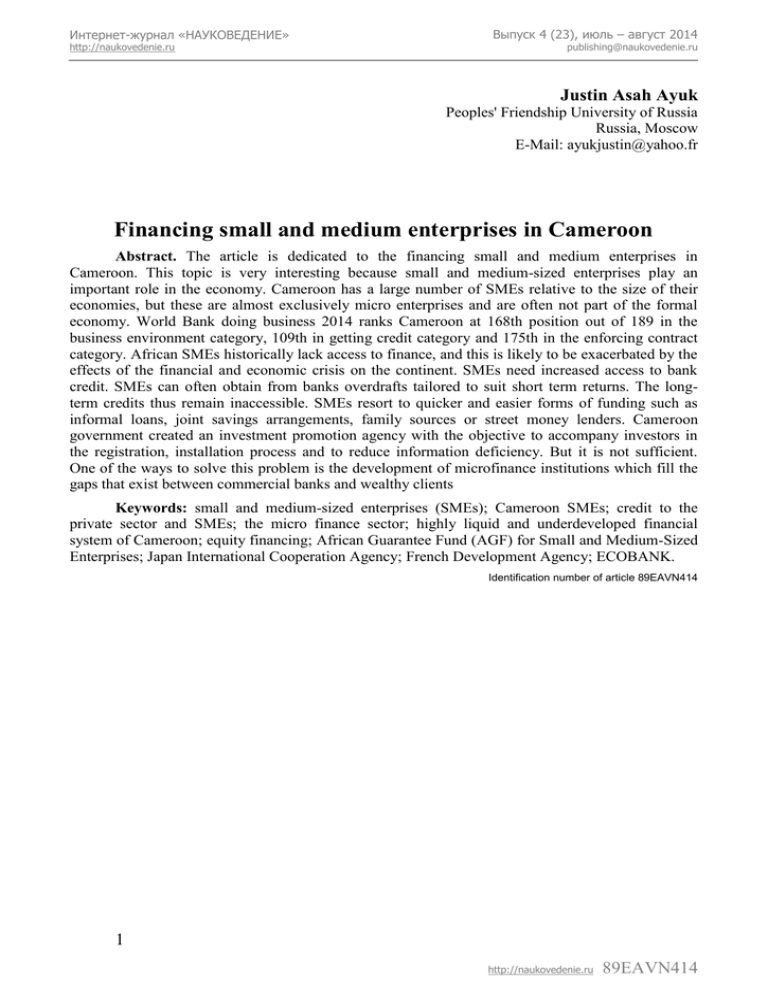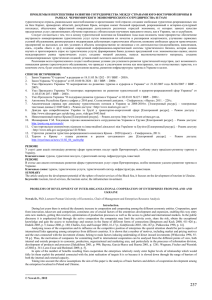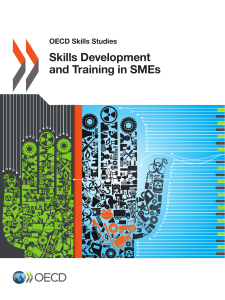Джастин Асах Аюк Финансирование предприятий малого и
реклама

Интернет-журнал «НАУКОВЕДЕНИЕ» http://naukovedenie.ru Выпуск 4 (23), июль – август 2014 [email protected] Justin Asah Ayuk Peoples' Friendship University of Russia Russia, Moscow E-Mail: [email protected] Financing small and medium enterprises in Cameroon Abstract. The article is dedicated to the financing small and medium enterprises in Cameroon. This topic is very interesting because small and medium-sized enterprises play an important role in the economy. Cameroon has a large number of SMEs relative to the size of their economies, but these are almost exclusively micro enterprises and are often not part of the formal economy. World Bank doing business 2014 ranks Cameroon at 168th position out of 189 in the business environment category, 109th in getting credit category and 175th in the enforcing contract category. African SMEs historically lack access to finance, and this is likely to be exacerbated by the effects of the financial and economic crisis on the continent. SMEs need increased access to bank credit. SMEs can often obtain from banks overdrafts tailored to suit short term returns. The longterm credits thus remain inaccessible. SMEs resort to quicker and easier forms of funding such as informal loans, joint savings arrangements, family sources or street money lenders. Cameroon government created an investment promotion agency with the objective to accompany investors in the registration, installation process and to reduce information deficiency. But it is not sufficient. One of the ways to solve this problem is the development of microfinance institutions which fill the gaps that exist between commercial banks and wealthy clients Keywords: small and medium-sized enterprises (SMEs); Cameroon SMEs; credit to the private sector and SMEs; the micro finance sector; highly liquid and underdeveloped financial system of Cameroon; equity financing; African Guarantee Fund (AGF) for Small and Medium-Sized Enterprises; Japan International Cooperation Agency; French Development Agency; ECOBANK. Identification number of article 89EAVN414 1 http://naukovedenie.ru 89EAVN414 Интернет-журнал «НАУКОВЕДЕНИЕ» http://naukovedenie.ru Выпуск 4 (23), июль – август 2014 [email protected] The large enterprises make the basis for national economies. Nevertheless, existence of only the big enterprises can't provide economic stability and effective development of market economy. The existence of the developed sector of small and medium-sized businesses is an indispensable condition for successful functioning of national economies. Small and medium-sized enterprises play an important role in the economy; they promote development of the competitive market environment, and fill consumer markets with goods, services and create new workplaces. Small and medium-sized enterprises (SMEs) have a short period of payback and are easy to start-up. Realization of economic potentials of SMEs is inseparably linked with the degree of satisfaction of their requirements for investments. Many countries in Sub Saharan Africa (SSA) have a large number of SMEs relative to the size of their economies, but these are almost exclusively micro enterprises and are often not part of the formal economy. Migration from micro to larger and innovative SMEs with the capacity to integrate global markets has remained a challenge for decades. In Cameroon, SMEs account for over 90% of the country’s economy and contribute 34% of GDP , yet only 20% receive a credit line from a financial institution2. According to a survey conducted by “Centre des Recherches et des Etudes en Economies et Sondage” (CRETES) 87.2 % of SMEs in Cameroon employ less than 20 employees, and 1.7 % employ more than 100 employees. 1 By the same institution, of the total of 2800 SMEs in the country, 2000 or 71% are operating in the secondary and tertiary sector.3 “The economy remains much less competitive because of the loan problem, corruption, tax policies, red tape and poor basic infrastructure according to 2003 – 2004 report on worldwide competitiveness.” (WEF 2005). World Bank doing business 2014 ranks Cameroon at 168th position out of 189 in the business environment category, 109th in getting credit category4 and 175th in the enforcing contract category. In a study conducted in 2011 on the evolution of private credits to GDP ratio in CEMAC, evidence of bank exclusion in the investment process in the sub region was presented (Justin Ayuk, 2012) (Tab.1). The size of Private sector credit to GDP remains limited below 7% of GDP as against 15% for low revenue Sub Saharan Africa, Tunisia 65.47% and 138 % for South Africa 5. In line with Trabelsi (2002), funds mobilized by the financial sector are not being transformed by the private sector into investment projects, implying the private sector is still rudimentary. This explains the phenomenon of excess liquidity of the banking system. Private sector credit as a ratio of GDP, which represents the actual volume of funds channelled to the private sector in an economy is directly attached to investment and economic growth (Jimborean, 2004). 1 National Institute of Statistics News release from African Guarantee Fund -AGF 3 Kenfack D.E.C. and Akinboade O.A. 2011. Regulations, SME Performance and Growth in Cameroon’s Manufacturing Sector (Dates of survey N/A). 4 A deterioration of performance as opposed to 2013. 5 2006 data for SSA, South Africa and Tunisia: UNECA-SRB, Les Economies de l’Afrique Centrale 2010 pg 279 2 2 http://naukovedenie.ru 89EAVN414 Выпуск 4 (23), июль – август 2014 Интернет-журнал «НАУКОВЕДЕНИЕ» [email protected] http://naukovedenie.ru Tab.1 Evolution of Private Credit to GDP to ratio for Cameroon/CEMAC Average Year/Country Cameroon CEMAC 19951997 8.16 5.93 19982000 8.20 6.43 20012003 8.94 6.12 20042005 9.20 5.94 20062007* 9.43 6.59 20082009* 9.72 6.04 2010 2011* 10.00 6.02 Source: Financial development and growth in CEMAC. Cameroon and the average for the CEMAC sub-region for the period 1995-20116. Cameroon presents an increasing linear trend, though with values levelling at 10% of GDP, indicating that the financial system is risk averse and does not participate in the economic development of the country (Pic.1). Evolution of Private Credit to GDP Ratio 12 10 8 6 4 2 0 1997 2000 2003 2005 2007* 2009* 2011* 2013* 1995- 1998- 2001- 2004- 2006- 2008- 2010 2012 Cameroon CEMAC Pic. 1. Evolution of Private Credit to GDP Ratio Source: Financial development and growth in CEMAC7. Despite a highly liquid and underdeveloped financial system 8, credit to the private sector and SMEs in particular remain scarce for lack of collateral. There exists a gap between those in need of funds and the available sources of investment capital, revealing the need of a buoyant private sector to attract and reallocate these funds into productive areas9. African SMEs historically lack access to finance, and this is likely to be exacerbated by the effects of the financial and economic crisis on the continent. SMEs need increased access to bank credit. Furthermore, high administrative costs and uncertainties about the future often make SMEs unattractive to potential funding sources in the private sector. The rate applied to financial intermediation in the micro finance sector in the CEMAC sub-region remains relatively high despite the intensification of competition. The average lending rate stands at 18% (with maximum lending attaining 30% in some countries). This would mean that average cost of credit can attain even 42%10. Reliability is doubtful because the linear model –Y=0.00x +4.950(R²=0.000) cannot capture a reasonable percentage of the variation. 7 Values are projections using linear regression analysis from previous years data obtained from UNECA/CA-SRB 8 Cameroons economy is experiencing an development trap 9 Op. cit 10 Cost include interest insurance and a processing fee of 1.5% of amount solicited (op cit.) 6 3 http://naukovedenie.ru 89EAVN414 Интернет-журнал «НАУКОВЕДЕНИЕ» http://naukovedenie.ru Выпуск 4 (23), июль – август 2014 [email protected] Classical banks practically don't give out credits to small enterprises. At issuance of credit, analysing formally by a traditional technique, for example, balance sheets, credit officers often come to a conclusion that, credits to SMEs is risky and turn down demands. Stock financing is available only to joint-stock companies. However, among SME enterprises, all shares are placed among internal shareholders. One of the advantages of stock (share) financing is the possibility of attracting resources in large volumes. Shortcomings of this type of financing is washing out of shares of the company and, as a result, loss of property and control over the enterprise. In Cameroon this type of financing is absent as a result of the existence of a financial market that has remained embryonic since its inception in 2001, characterised by a less dense industrial tissue constituted of local enterprises. Equity financing provides investment implementation in business at the expense of own means. The main sources of self-financing are, first of all, retained earnings and also depreciation and amortization. When enterprises use such a reliable source as equity, the risk of bankruptcy decreases. Moreover, ability of equity financing means financial stability of the enterprise that adds competitive advantages to the subject of SMEs. However there are shortcomings of this type of financing, such as the high inflation leading to depreciation of own source of financing, and also derivation of means from economic circulation. Naturally, this source of financing is suitable only for already operating SMEs. The most significant type of financing is bank crediting. In the event of already operating enterprises the bank credit provides the development of business. But when the returns of SMEs are highly uncertain it is difficult to assess their monetary value before they become commercially successful (OECD, 2004). The main underlying factor here is that commercial banks do not serve poor clients located in the rural areas with small loans. However, there are some mechanisms which small businesses use in practice. SMEs can often obtain from banks overdrafts tailored to suit short term returns. The long-term credits thus remain inaccessible. SMEs have no sufficient volume of assets for granting them as pledge subjects for long-term credits. Consequently SMEs resort to quicker and easier forms of funding such as informal loans, joint savings arrangements, family sources or street money lenders. Here interest charges including insurance and processing fees can amount to 30% per annum. A survey of 300 SMEs from the manufacturing sector carried out in 2001 confirmed that SMEs increasingly needed expansion capital. There is a strong economic case for scaling up support for African SMEs. Development assistance for SMEs in Africa remains highly fragmented, with several donors and development finance institutions running a number of SME programs in an uncoordinated way. A regionalization of support and a pooling of resources are required to avoid duplications and inefficiencies, in the spirit of the Paris Declaration and the Accra Agenda for Action. The necessity to develop a private sector capable of contributing to the development of the country is gradually finding grounds within decision making. Recently the Cameroon government in 2013 signed a decree creating a bank for SMEs with a capital of XAF10 billion (USD 20 000 000). This bank with the Board of Directors appointed already, including a General Manager is expected to go operational in 2014. It is necessary to develop and use forms of policy implementation which can directly impact the investment process, generating benefits for small enterprises and investors. In this light, the Cameroon government created an investment promotion agency with the objective to accompany investors in the registration, installation process and to reduce information 4 http://naukovedenie.ru 89EAVN414 Интернет-журнал «НАУКОВЕДЕНИЕ» http://naukovedenie.ru Выпуск 4 (23), июль – август 2014 [email protected] deficiency on general and specific economic incentives for private investments which complete the implementation of laws. This incentives privileged SMEs at different levels of operation.11 Furthermore, as at 2013 several agreements have been reached in favour of SMEs in a bid to improve on their financial needs. The African Guarantee Fund (AGF) for Small and Medium-Sized Enterprises signed a protocol agreement worth USD 200 million with GICAM and a consortium of banks (Société Générale des Banques-SGBC, Afriland First Bank, Ecobank and BGFI) to set up a pilot project for financing and supporting SMEs in Cameroon. This agreement seeks to enhance access to financing and also capacity building support aimed at improving managerial skills. AGF is a Pan-African non-bank financial institution owned by the African Development Bank (AfDB), Danish International Development Agency (Danida) and Spanish Agency for International Development Cooperation (aecid). AGF was officially launched on 1st June 2012. AGF’s primary mandate is to assist financial institutions (banks, private equity funds, lease finance houses and development finance institutions) in Africa to scale up their SME financing through the provision of partial loan guarantees and SME financing Capacity Development Assistance. The Japan International Cooperation Agency (JICA) in October 2013, was engaged in negotiations to work within the framework of the National Development Agency on a project to promote SMEs in Cameroon. It is aimed at creating development centres for SMEs in the country’s regions and a link between the functioning of JICA and the SME bank12. The French Development Agency (FDA) through its programme “ariz” for the financing of private investments in areas of the Agency’s intervention has signed an agreement with SCB/Attijariwafa bank to assist SMEs financially. The convention worth €5million (USD 6.5 million) will serve 50% of loans that the bank will give to SMEs. Within a period of two years SMEs can obtain up to XAF 200 million (USD 413 000). In the same light International Finance Cooperation (IFC) support for SMEs in Cameroon is focused on a partnership with ECOBANK in which IFC is helping ECOBANK develop and expand an SME lending program that aims at providing small businesses with the financing they need to grow and take on new employees. With this support ECOBANK increased its lending from about USD 9 million in 2009 to USD 15 million in 2010. Furthermore, ECOBANK aimed at having an SME unit in all its 22 branches in Cameroon by the end of 2011. With numerous government initiatives to support SMEs and an over liquid financial system, SMEs still have remained on the edge with no prospects or knowledge of how to upgrade or improve standards to meet with global demand. SMEs are not only the most important source of increase of gross domestic product they are also the integral element of modernization of the economy, that is, the priority direction of domestic economies. Therefore improvement of methods of financing of subjects of SMEs, both from the state, and from private institutes of financing is the integral link of its development. One of the ways to solve this problem is the development of microfinance institutions which fill the gaps that exist between commercial banks and wealthy clients. They are to meet the needs of those who cannot get bank credits and loans. Microfinance institutions are credit unions, and they provide services which the banks do not offer. These services include; low interest rates, not so strict collateral and generally encouraging banking conditions. Microfinance institutions are suitable for Finance law Nº 2007/005 of 26 December 2007 Order Nº 2008/2304/PM of 29 July 2008 to define the regime of structural Projects of the General Tax Code; article 113 to 116 of the General Tax Code. 12 Business in Cameroon. Thursday 24 October 2013 11 5 http://naukovedenie.ru 89EAVN414 Интернет-журнал «НАУКОВЕДЕНИЕ» http://naukovedenie.ru Выпуск 4 (23), июль – август 2014 [email protected] developing and transition countries. The services they provide are tailored to meet the needs and aspirations of the local inhabitants and emphases are towards the poor. It is possible to claim with confidence about the expediency of formation of the organizational, infrastructural and legal environment of activities of microfinance institutions in Cameroon. There is a considerable demand for micro financing which isn't satisfied by banks and other formal participants of this market. Thus it is possible to predict the absence of strong contenders for the program for the next years. In case of the implementation of the program it will not only have direct effects connected with strengthening and development of SMEs, but also a number of additional benefits, such as a reduction of the informal credit market, strengthening of incentives for businessmen to reduce illegal trade, development of the working skills of businessmen with credits and creation of their credit stories which will further simplify their relationship with banks. 6 http://naukovedenie.ru 89EAVN414 Выпуск 4 (23), июль – август 2014 Интернет-журнал «НАУКОВЕДЕНИЕ» [email protected] http://naukovedenie.ru REFERENCES 1. ARUWA SAS. Financing Options for Small and Medium Scale Enterprises in Nigeria.Business in Cameroon, Thursday 31 October 2013, online 2. Cameroon-info.net: Agriculture and SMEs. International Finance Cooperation. World Bank Group, online 3. Justin Ayuk 2012. Financial Developments and Growth in the CEMAC Zone, LAP Lamberts Academic Publishing, Nordderstedt Germany. 4. Kenfack Djoumessi E.C. & Akinboade O.A. 2011. Regulation, SME Performance and Growth in Cameroon’s Manufacturing and Retail Sector. Trust Africa. Pretoria. South Africa. 5. New financing window for Cameroon SMEs. Business in Cameroon, Thursday 24 October 2013 MSME News Network, Thursday 17 October 2013 6. Nzepa O. N. and Keutchankeu R. T. 2006. Towards an African e-Index. SME e-access and Usage across 14 African Countries. 7. OECD 2004, Promoting Entrepreneurship and Innovative SMEs in a Global Economy: Financing for SMEs page 17-20. Istanbul, Turkey. 8. SEPnET. Factors Determining Horizontal Cooperation amongst SMEs in Cameroon. Dar Es Salaam, Tanzania 9. Tom Gibson & Van der Vaart H.J. 2008. A Less Imperfect Way of Defining Small and Medium-Sized Enterprises in Developing countries. (www.brookings.edu/~/media/research/.../09_development_gibson.pdf). 10. World Bank. 2013. Doing Business 2014: Economy Profile: Cameroon. Understanding Regulations for Small and Medium-Sized Enterprises. Washington, DC: World Bank Group. 7 http://naukovedenie.ru 89EAVN414 Интернет-журнал «НАУКОВЕДЕНИЕ» http://naukovedenie.ru УДК Выпуск 4 (23), июль – август 2014 [email protected] 336.647/.648 Джастин Асах Аюк ФГБОУ ВПО «Российский университет дружбы народов» Россия, Москва13 Аспирант кафедры «Финансы и кредит» экономического факультета E-Mail: [email protected] Финансирование предприятий малого и среднего бизнеса в республике Камерун Аннотация. Статья посвящена проблему финансирования малых и средних предприятий в Камеруне. Эта тема очень интересна, так как малые и средние предприятия играют важную роль в экономике. В Камеруне есть большое количество малых и средних предприятий, но они - почти исключительно микро предприятия и часто являются не частью экономики. Всемирный банк, в своем исследовании о степени привлекательности бизнеса, проведенном в 2014 году поставил Камерун на 168 место среди 189 стран по качеству деловой среды, на 109 по возможности получить кредит. Африканские малые и средние предприятия исторически испытывают недостаточность финансирования, что вероятнее всего, будет все сильнее проявляться в условиях финансового и экономического кризиса на континенте. Малые и средние предприятия испытывают потребность в банковском кредите, однако в силу множества проблем его не получают. Малые и средние предприятия могут лишь в большинстве случаев получить овердрафт для покрытия кассовых разрывов и обеспечения платежей или воспользоваться иным видом краткосрочного кредитования. Долгосрочные кредиты таким предприятиям остаются недоступными. Именно поэтому малые и средние предприятия Камеруна обращаются к более быстрым и более легким формам финансирования, таким как неофициальные кредиты, ссуды ростовщиков, накопления домохозяйств или пользуются услугами уличных кредиторов. С целью улучшения доступа к кредиту Камерунское правительство создало инвестиционное агентство по продвижению, основной целью которого является информационное сопровождение инвесторов и предоставление гарантий. Однако, учитывая современные реалии этого недостаточно. Поэтому, принимая во внимание современные реалии необходимо создавать в Камеруне микрофинансовые организации, основной целью деятельности которых будет являться предоставление кредита малым и средним предприятиям. Ключевые слова: Малые и средние предприятия; Камерунские малые и средние предприятия; кредит частному сектору и малым и средним предприятиям; микро финансовый сектор; микрофинансирование; Африканский гарантийный фонд (AGF) для малых и средних предприятий; Служба международного сотрудничества Японии; Французское агентство по вопросам развития; ECOBANK. Идентификационный номер статьи в журнале 89EAVN414 13 117198, ул. Миклухо-Маклая, д.6 8 http://naukovedenie.ru 89EAVN414 Выпуск 4 (23), июль – август 2014 Интернет-журнал «НАУКОВЕДЕНИЕ» [email protected] http://naukovedenie.ru ЛИТЕРАТУРА 1. ARUWA SAS. Financing Options for Small and Medium Scale Enterprises in Nigeria.Business in Cameroon, Thursday 31 October 2013, online 2. Cameroon-info.net: Agriculture and SMEs. International Finance Cooperation. World Bank Group, online 3. Justin Ayuk 2012. Financial Developments and Growth in the CEMAC Zone, LAP Lamberts Academic Publishing, Nordderstedt Germany. 4. Kenfack Djoumessi E.C. & Akinboade O.A. 2011. Regulation, SME Performance and Growth in Cameroon’s Manufacturing and Retail Sector. Trust Africa. Pretoria. South Africa. 5. New financing window for Cameroon SMEs. Business in Cameroon, Thursday 24 October 2013 MSME News Network, Thursday 17 October 2013 6. Nzepa O. N. and Keutchankeu R. T. 2006. Towards an African e-Index. SME e-access and Usage across 14 African Countries. 7. OECD 2004, Promoting Entrepreneurship and Innovative SMEs in a Global Economy: Financing for SMEs page 17-20. Istanbul, Turkey. 8. SEPnET. Factors Determining Horizontal Cooperation amongst SMEs in Cameroon. Dar Es Salaam, Tanzania 9. Tom Gibson & Van der Vaart H.J. 2008. A Less Imperfect Way of Defining Small and Medium-Sized Enterprises in Developing countries. (www.brookings.edu/~/media/research/.../09_development_gibson.pdf). 10. World Bank. 2013. Doing Business 2014: Economy Profile: Cameroon. Understanding Regulations for Small and Medium-Sized Enterprises. Washington, DC: World Bank Group. Рецензент: Рыбакова Ольга Викторовна, доктор экономических наук, профессор кафедры экономики и финансов общественного сектора Российской академии народного хозяйства и государственной службы при Президенте РФ. 9 http://naukovedenie.ru 89EAVN414



